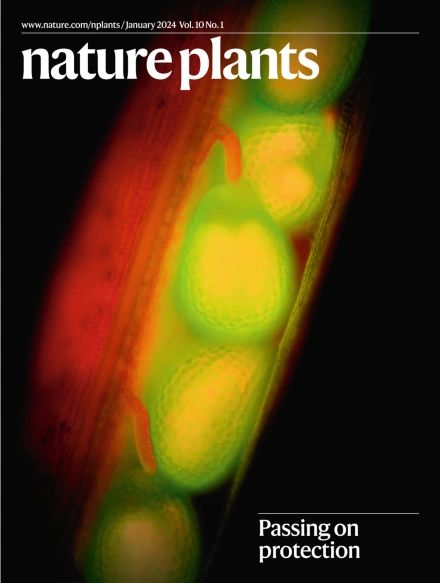Cell cycle repressor promotes pollen mitosis
IF 15.8
1区 生物学
Q1 PLANT SCIENCES
引用次数: 0

细胞周期抑制因子促进花粉有丝分裂
在雄性生殖系发育过程中,小孢子不对称地分裂成较大的营养细胞和较小的生殖细胞。花粉有丝分裂I之后是生殖细胞的第二次对称分裂,形成两个精核,细胞周期停留在G1期,直到受精。众所周知,PMII需要R2R3 MYB转录因子DUO1,并且DUO1突变体在分裂前的S期停滞。DUO1受at - rich DOMAIN-CONTAINING PROTEIN 1 (ARID1)的转录控制,并在mRNA水平上受microrna的影响。与DUO1控制PMII进入相反,PMII后分裂被阻止的机制尚不清楚。研究人员关注RBR1,因为已知其动物同源物与ARID转录因子相关。事实上,Li和同事使用互反共免疫沉淀试验来证实RBR1与ARID1相互作用。由于rbr1基因敲除突变体在配子体上是致命的,作者分离出了rbr1-4等位基因,该基因产生一个3′截断的转录物,导致缺乏部分C端的不稳定蛋白。尽管rbr1-4突变体明显存在生殖缺陷,但这种表型与生殖细胞过度增殖无关,而是与生殖细胞增殖不足相关,从而导致仅含有单个精子核的花粉比例较高。作者表明RBR1以依赖arid1的方式与DUO1相互作用,这种相互作用稳定了DUO1。由于在RBR1 -4突变体中,尽管转录物水平较高,但DUO1蛋白水平降低,因此可以假设RBR1的极端C端需要稳定DUO1。这些发现表明RBR1需要与ARID1和DUO1一起促进PMII。有趣的是,之前有报道称,更强的rbr1突变等位基因会导致生殖细胞过度增殖,这表明rbr1可能也需要抑制PMII后的进一步分裂。因此,我们很容易推测,DUO1需要RBR1的稳定,以协调PMII与一种防止此后额外分裂的机制。
本文章由计算机程序翻译,如有差异,请以英文原文为准。
求助全文
约1分钟内获得全文
求助全文
来源期刊

Nature Plants
PLANT SCIENCES-
CiteScore
25.30
自引率
2.20%
发文量
196
期刊介绍:
Nature Plants is an online-only, monthly journal publishing the best research on plants — from their evolution, development, metabolism and environmental interactions to their societal significance.
 求助内容:
求助内容: 应助结果提醒方式:
应助结果提醒方式:


